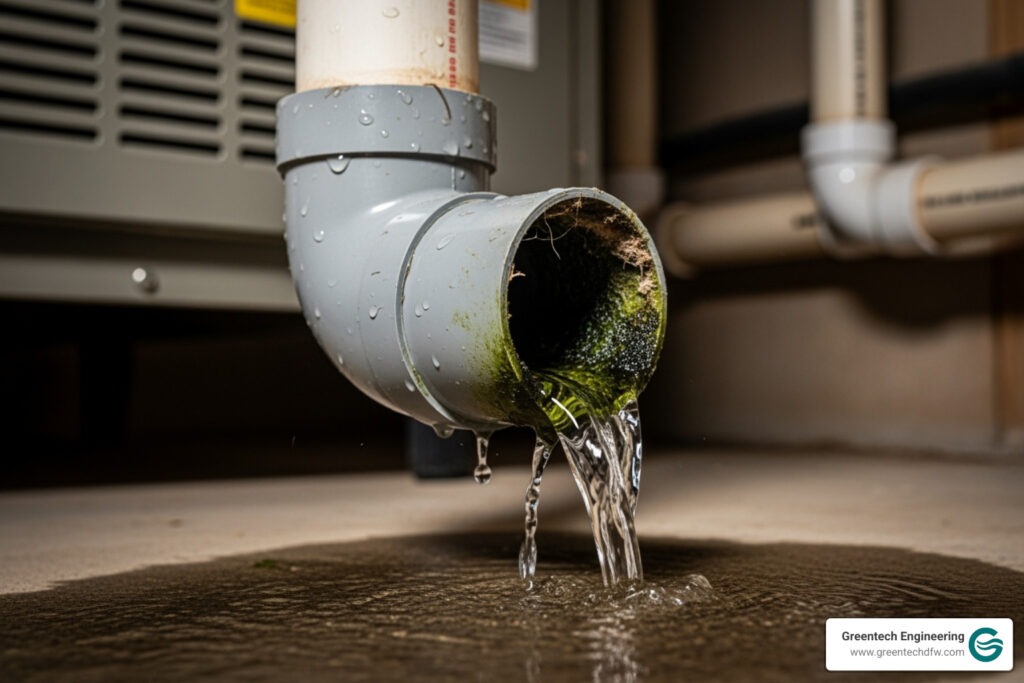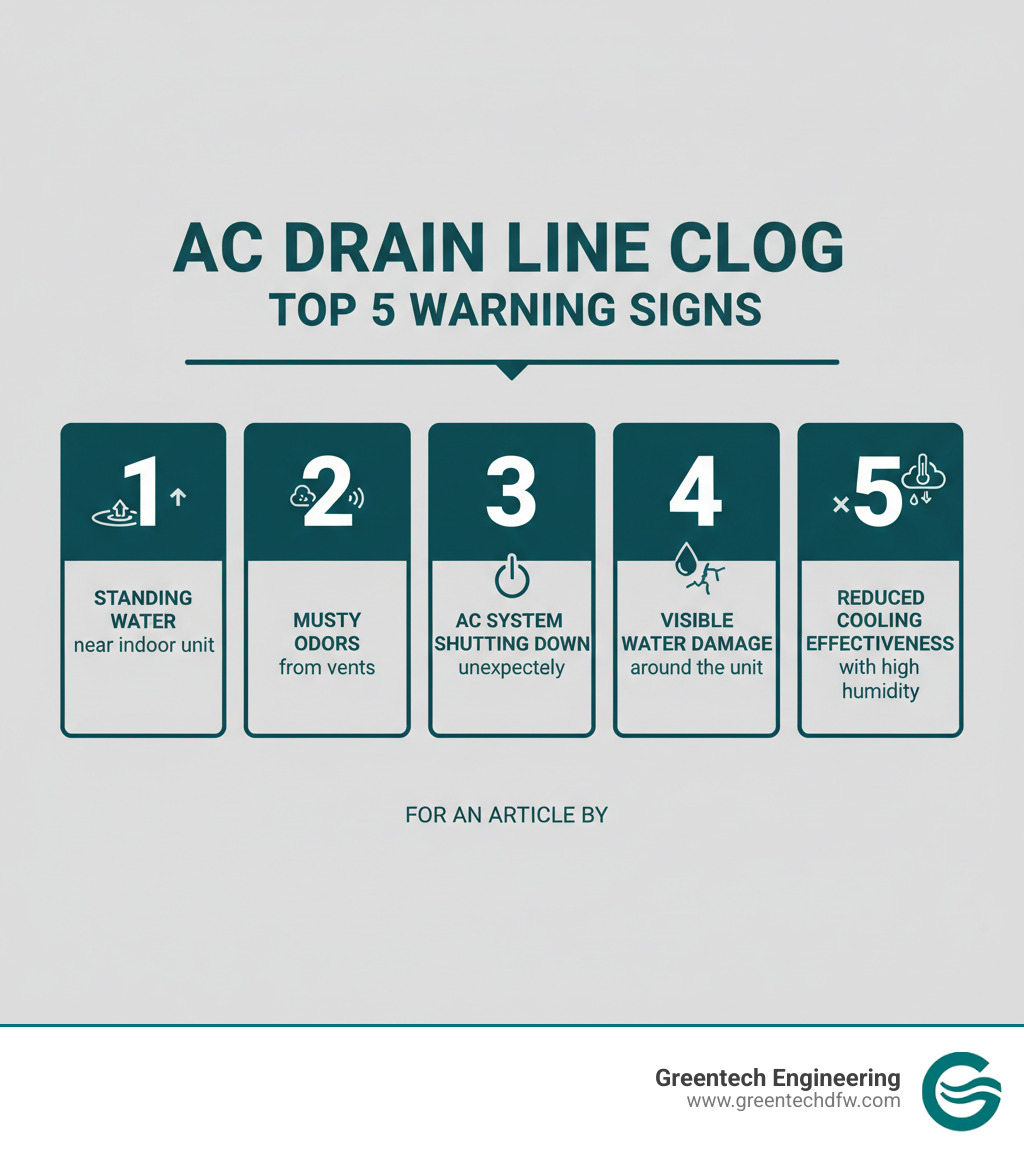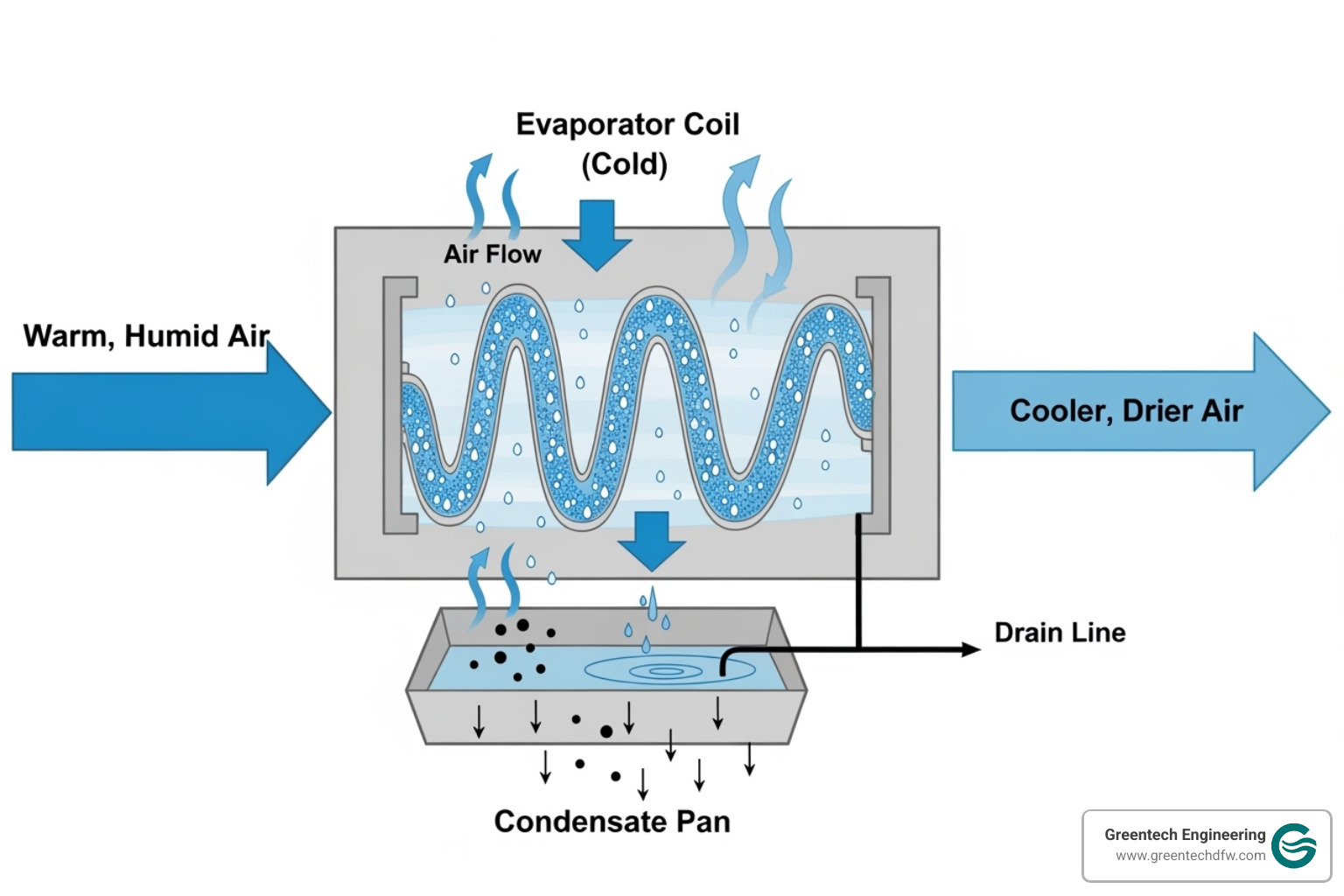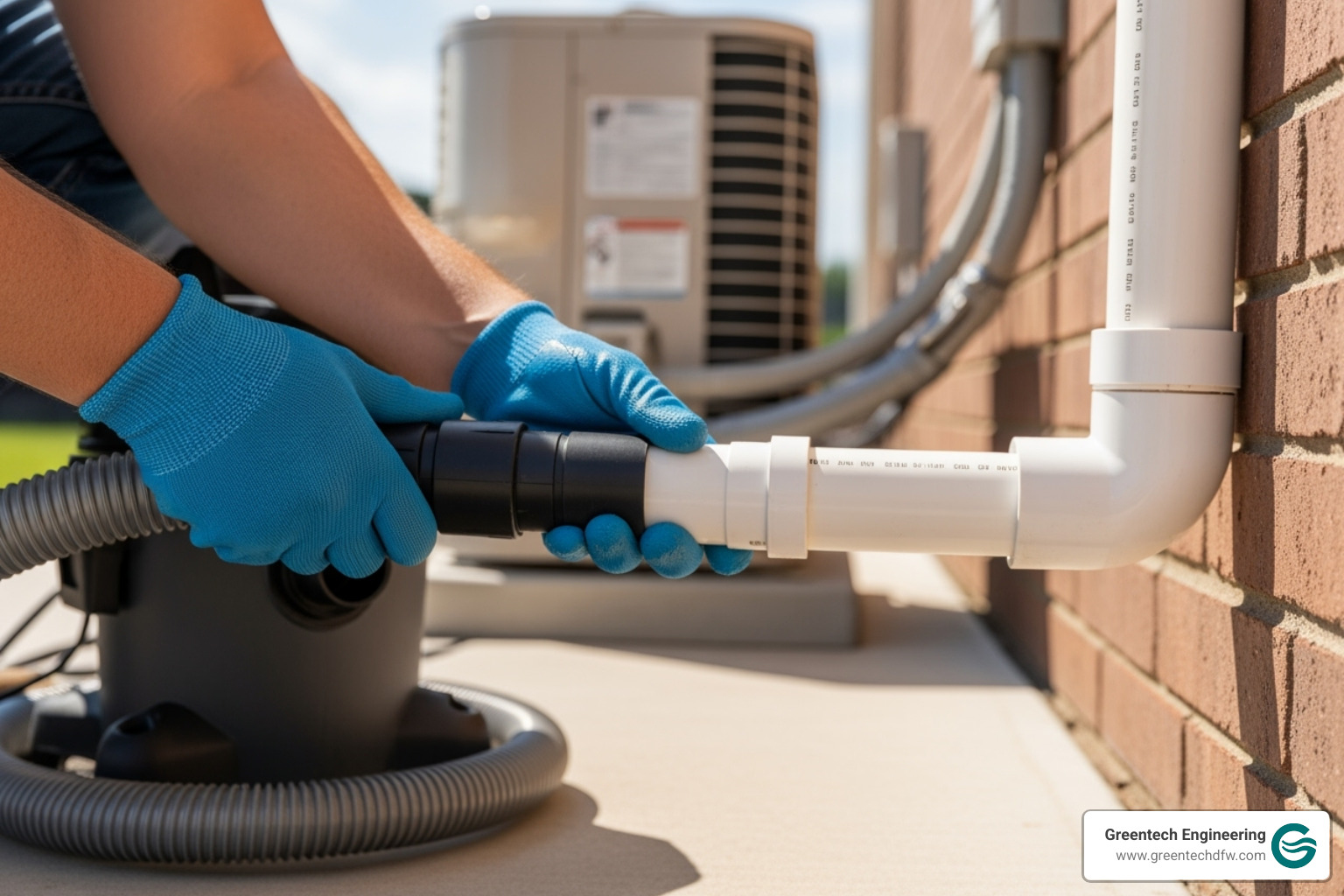Why an AC Drain Line Clog Can Shut Down Your Entire System
An AC drain line clog can quickly turn your comfortable home into a humid mess. Your air conditioner removes up to 20 gallons of moisture from the air daily during hot DFW summers, and if the drain line gets blocked, you could face standing water, system shutdowns, and water damage.
Quick Solutions for AC Drain Line Clogs:
- Turn off your AC immediately if you see standing water
- Use a wet/dry vacuum to suction debris from the drain line
- Flush with distilled vinegar to kill algae and bacteria
- Call a professional if water damage has occurred or the system won’t restart
The good news is that most clogs are preventable with simple monthly maintenance, and many can be cleared with DIY methods. Your AC’s condensate drain system carries away moisture from the evaporator coil, but algae, mold, or sludge can cause it to fail, a common issue in North Texas humidity. While some situations require professional help, many homeowners can tackle minor clogs themselves.
Understanding Your AC’s Condensate Drain System
Your air conditioner is essentially a massive dehumidifier that also cools your home. During sweltering DFW summers, your AC works overtime to pull moisture from the air. Understanding this process helps you spot problems early.
The process begins at the evaporator coil, a network of cold metal coils in your indoor unit. As warm, humid air passes over the coil, moisture condenses into water droplets, similar to a cold soda can “sweating.” In North Texas, your AC can remove up to 20 gallons of water from the air daily.
This water drips into the condensate pan (or drip pan) below the coil. Gravity then pulls the water into the primary drain line, a PVC pipe that carries it outside. Most systems also have a secondary drain line as a backup. If the primary line has an AC drain line clog, this secondary line helps prevent overflow and water damage. When this water removal system works correctly, it’s silent and automatic. But when it fails, the problems become obvious quickly.
Telltale Signs of an AC Drain Line Clog
How do you know if your AC drain line is backing up? Ignoring the warning signs can lead to expensive problems, so it’s wise to be vigilant.
One of the most obvious indicators is standing water near the indoor unit. This usually means the condensate pan is overflowing. A puddle is a clear sign of a drainage issue, and you might also see water damage like stains on floors or drywall.
Another sign is your AC system shutting down or not turning on. Many modern units have a safety float switch in the drip pan. If water fills the pan due to a clog, the switch triggers, shutting down the unit to prevent water damage.
A musty or moldy smell from your vents is another red flag. This odor comes from standing water and mold growth in the drain line. Stagnant moisture creates a perfect breeding ground for mold, which isn’t just unpleasant; it can also lead to health complications, as the CDC warns.
Finally, if your AC isn’t cooling effectively or your home feels muggy, a clog could be the culprit. A partial clog forces the unit to work harder to remove humidity, making your home less comfortable. It can also cause the evaporator coils to freeze, leading to a system shutdown.
If you notice any of these symptoms, take action. Early detection can save you from costly repairs.
Common Culprits: What Causes Drain Line Clogs?
An AC drain line clog develops gradually. Understanding the common causes can help you prevent them.
The biggest culprit is algae growth. The dark, damp environment of your drain line is a perfect breeding ground for algae, which feeds on dust in the condensate water. Over time, it forms a slimy coating that can cause a complete blockage.
Mold and mildew thrive in the same conditions, contributing to slime and sludge buildup. This mixture of moisture, biological growth, and debris can plug your drain line. High humidity in North Texas accelerates this problem.
Everyday dust and debris also contribute. Even with a good filter, particles like dust and pet dander can reach the evaporator coil. Condensation washes this debris into the drain line, where it mixes with biological growth to form a clog.
Clogs can also form during the off-season. Sludge left in the line can dry into a hard blockage that causes problems when you turn the AC back on in the spring.
Finally, improper installation can lead to recurring clogs. If the drain line lacks the proper slope or has too many sharp bends, water can pool, allowing debris to settle and build up. Living in a humid climate like the Greater DFW area makes these issues more common, but understanding them is the first step to prevention.
How to Unclog Your AC Drain Line: A Step-by-Step DIY Guide
Many homeowners can clear a minor AC drain line clog with a few basic tools.
First, safety: Always turn off your AC unit completely at both the thermostat and the circuit breaker for the indoor and outdoor units.
Gather your supplies: a wet/dry shop vacuum, distilled white vinegar, a stiff-bristled brush, rags, and duct tape. A garden hose or plumber’s snake can also be useful.
- Locate the drain line. Find the PVC pipe with a T-shaped access vent (usually with a cap) near your indoor air handler and where it exits your home, typically near the outdoor unit.
- Clean up standing water. If the condensate pan has overflowed, use towels or a shop vac to remove the water. Brush away any visible gunk from the drain hole in the pan.
- Use a wet/dry vacuum. Go to the outdoor exit of the drain line. Create a tight seal between the shop vac hose and the pipe using duct tape or a rag. Turn on the vacuum for 2-3 minutes to suction out the clog. A gush of water and debris means it’s working.
- Flush the line. After vacuuming, pour a cup of clean water into the indoor access point to ensure it flows freely out the other end. You can also gently run water from a garden hose through the line from the outside.
- Tackle stubborn clogs. For blockages that won’t budge, carefully insert a plumber’s snake from the indoor access point to break it up. Flush with water afterward.
Once the clog is clear, replace any caps, restore power, and test your system.
A Simple DIY Fix for a Minor AC Drain Line Clog
For minor clogs or preventative maintenance, a monthly vinegar flush is highly effective at killing algae, mold, and bacteria.
Turn off your AC, then locate the T-shaped access point on the condensate line. Remove the cap and slowly pour about 1/4 cup of distilled white vinegar into the line. Hydrogen peroxide or hot water with a few drops of dish soap are good alternatives.
Let the solution sit for 30 minutes to break down any buildup. Afterward, flush the line with a cup of clean water. Making this a monthly habit during DFW summers can prevent a major AC drain line clog and keep your system reliable.
Prevention is Key: Keeping Your Drain Line Clear
Proactive steps can save you from the hassle of an AC drain line clog, especially in the Greater DFW Area where air conditioners work hard for months.
- Change your air filter regularly. A clean filter prevents dust, pet hair, and other debris from reaching your evaporator coil. When a filter is clogged, this debris gets washed into the drain line, causing blockages. We recommend changing your filter every 1-3 months. A clean filter can also lower your AC’s energy use by up to 15%, according to Energy.gov.
- Perform a monthly vinegar flush. As described previously, pouring 1/4 cup of distilled white vinegar down the access point each month kills mold and algae before they build up.
- Keep your outdoor unit clear. Ensure the area around your outdoor condenser is free of leaves, grass, and shrubs. This helps the entire system run more efficiently, reducing stress on the drainage system.
- Check the condensate pan. Every few months, inspect the pan for standing water or slime and clean it if necessary.
- Consider condensate pan tablets. For homes in humid areas, these slow-dissolving tablets can provide extra protection against algae and mold growth.
Incorporating these simple steps into your home maintenance routine will dramatically reduce your risk of a disruptive AC drain line clog.
The Role of Regular Maintenance in Preventing an AC Drain Line Clog
While DIY prevention is great, nothing replaces a professional HVAC tune-up. It’s like an annual physical for your AC.
During a maintenance visit, our Greentech Engineering technicians perform a thorough inspection of the entire condensate system to prevent problems before they start. Our professional cleaning process uses specialized equipment like nitrogen blasts and industrial-grade vacuums to clear even the most stubborn buildup from the drain line and evaporator coil.
We are also trained to spot potential issues like an improper drain line slope or a deteriorating pan, fixing them before they become emergencies. In humid climates, drain-related issues can account for a high percentage of HVAC service calls. Professional maintenance significantly reduces your chances of becoming one of those statistics.
Regular professional service not only prevents an AC drain line clog but also improves efficiency, extends your system’s lifespan, and provides peace of mind that your AC is ready for the Texas heat.
When to Call a Professional HVAC Technician
While many AC drain line clog issues are DIY-friendly, some situations require a professional. Calling for help is essential for your home’s safety and comfort in these cases.
- Severe water damage: If you have flooded floors, water-stained ceilings, or damaged belongings, call a professional immediately. Quick intervention is needed to prevent widespread structural issues.
- Health concerns from mold: A persistent musty smell or visible mold growth poses health risks. Professional mold remediation is necessary for safe and effective removal.
- Complete system shutdown or frozen coils: If your AC won’t turn on or you see ice on the evaporator coils, it indicates a problem beyond a simple clog. A professional diagnosis is required to get your system running safely again.
- DIY methods have failed: If you’ve tried vacuuming and flushing the line without success, it’s time to call an expert. Forcing the issue can cause more damage.
- Inaccessible or recurring clogs: Clogs deep within walls or that repeatedly come back signal an underlying problem, such as improper installation, that needs a professional solution.
Our Greentech Engineering team has extensive experience with drain line issues in DFW homes. We can diagnose the root cause and provide a lasting solution, like the drain system redesign we performed for a Frisco homeowner. When facing a stubborn clog, don’t hesitate to reach out for help.
Conclusion
A puddle of water near your AC unit is more than an inconvenience; it’s a red flag. An AC drain line clog can lead to standing water, musty odors, and sudden system shutdowns, especially during our sweltering DFW summers.
You are now equipped to spot the warning signs and, in many cases, resolve the issue yourself with a wet/dry vacuum and a monthly vinegar flush. These simple actions can save you from major headaches.
However, it’s also crucial to know when to call for backup. Severe water damage, mold issues, or a system that won’t restart are signs that you need professional help. At Greentech Engineering, our honest, straightforward approach means we provide the right solution, from clearing simple clogs to complex drain system redesigns.
Don’t let a clogged drain line ruin your comfort. Regular maintenance is your best defense.
Schedule your professional air conditioning service today, and let our Greentech Engineering team ensure your AC system keeps you cool and comfortable all year long in the Greater DFW Area.











